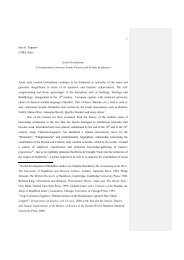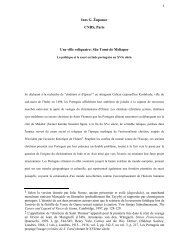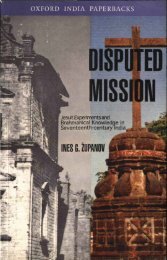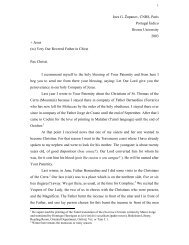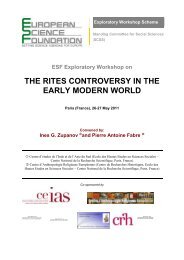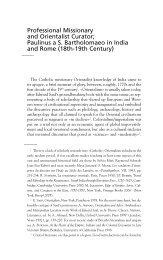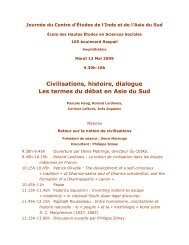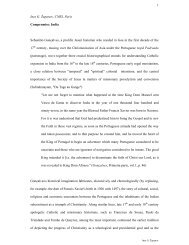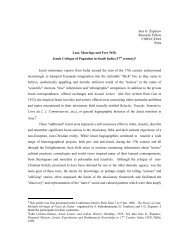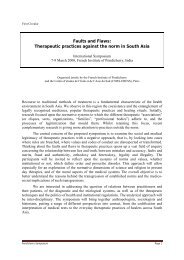Drugs, Health, Bodies and Souls in the Tropics ... - Ines G. Županov
Drugs, Health, Bodies and Souls in the Tropics ... - Ines G. Županov
Drugs, Health, Bodies and Souls in the Tropics ... - Ines G. Županov
Create successful ePaper yourself
Turn your PDF publications into a flip-book with our unique Google optimized e-Paper software.
23<br />
Heroic <strong>in</strong>dividual feats, especially martyrdom were not whole-heartedly encouraged,<br />
as this was suspected of be<strong>in</strong>g reckless <strong>and</strong> wasteful behavior. In <strong>the</strong> light of a<br />
hagiographic history or an edify<strong>in</strong>g letter re-tell<strong>in</strong>g a recent death <strong>in</strong> <strong>the</strong> field,<br />
regardless of whe<strong>the</strong>r it qualified for red or white martyrdom, Jesuit martyrs were<br />
cherished <strong>and</strong> <strong>the</strong>ir deeds amplified to suit European readers <strong>and</strong> to boost <strong>the</strong> spirits<br />
<strong>and</strong> expectations of <strong>the</strong> young novices <strong>and</strong> o<strong>the</strong>r members. The Jesuit argument was<br />
that <strong>the</strong>re was noth<strong>in</strong>g <strong>in</strong>tr<strong>in</strong>sically bad <strong>in</strong> dy<strong>in</strong>g as a witness of faith, <strong>in</strong> <strong>the</strong> manner of<br />
an early Christian sa<strong>in</strong>t, but that it was even better to exercise "discretion" <strong>and</strong><br />
prudence <strong>and</strong> preserve one's body for more strenuous work. 112 In fact, each case of<br />
martyrdom was looked <strong>in</strong>to by <strong>the</strong> Jesuit authorities <strong>in</strong> order to discern whe<strong>the</strong>r <strong>the</strong><br />
death could have been avoided, or was <strong>in</strong>evitable <strong>and</strong> thus div<strong>in</strong>ely <strong>in</strong>spired. The first<br />
death of a member of <strong>the</strong> Society <strong>in</strong> India, Antonio Crim<strong>in</strong>ali, who had been struck by<br />
an "<strong>in</strong>fidel" h<strong>and</strong>, was judged imprudent <strong>in</strong> spite of a torrent of enthusiastic letters<br />
about his courage. 113<br />
Circuitously, descriptions of scenes of martyrdom <strong>and</strong> of tortured <strong>and</strong><br />
fractured bodies serve as one more proof of Jesuit adaptability. Staged as a<br />
providential, but temporarily tragic battle between forces of good <strong>and</strong> evil, martyrdom<br />
was <strong>the</strong> surest <strong>in</strong>scription of <strong>the</strong> Christian message on <strong>the</strong> pagan l<strong>and</strong>scape. The blood<br />
spilled on <strong>the</strong> ground becomes a fertile compost for <strong>the</strong> new Christian v<strong>in</strong>e, accord<strong>in</strong>g<br />
to <strong>the</strong> Jesuit historical imag<strong>in</strong>ation employed to make <strong>the</strong> best of an o<strong>the</strong>rwise<br />
complicated issue. In <strong>the</strong> same way, local religious folklore <strong>in</strong> Salsete, south of Goa,<br />
where <strong>the</strong> second <strong>and</strong> more important martyrdom occurred <strong>in</strong> 1583, accorded a special<br />
place to <strong>the</strong> spill<strong>in</strong>g of blood. Martyrs, just like any o<strong>the</strong>r type of martial heroes, were<br />
easily translated <strong>in</strong>to <strong>the</strong> tutelary deities of particular l<strong>in</strong>eages <strong>and</strong> clans. In <strong>the</strong><br />
seventeenth century, <strong>the</strong> blood of a Jesuit missionary, João de Brito, would transform<br />
<strong>the</strong> color of <strong>the</strong> s<strong>and</strong> <strong>in</strong>to terra-cotta red. To this day, it is reputed to have<br />
thaumaturgic qualities <strong>and</strong> is taken away as a relic from Oriyur by <strong>the</strong> pilgrims.<br />
Before <strong>the</strong> Jesuit martyrs left <strong>the</strong>ir blood <strong>and</strong> bones <strong>in</strong> <strong>the</strong> soil, European relics<br />
were steadily imported. We read about <strong>the</strong>m on <strong>the</strong> ships where <strong>the</strong>y helped to calm<br />
<strong>the</strong> stormy wea<strong>the</strong>r <strong>and</strong> turbulent seas. They were paraded <strong>in</strong> processions or, <strong>in</strong> <strong>the</strong><br />
last moment of extreme danger, thrown <strong>in</strong>to <strong>the</strong> sea. All <strong>the</strong>se <strong>and</strong> similar rituals<br />
mark<strong>in</strong>g, as some would say, <strong>the</strong> possession of space, appear as favorite topoi <strong>in</strong> <strong>the</strong><br />
literature of maritime disasters, <strong>in</strong> Jesuit correspondence <strong>and</strong> <strong>in</strong> hagiographic histories<br />
<strong>and</strong> pa<strong>in</strong>t<strong>in</strong>gs. 114 Just as Portuguese "discoverers" planted memorial columns<br />
(padrãos) along <strong>the</strong> coasts of <strong>the</strong>ir maritime passage, as an exaggerated token of <strong>the</strong>ir<br />
presence <strong>and</strong> <strong>the</strong>ir claim to proprietorship of <strong>the</strong> l<strong>and</strong>, Jesuit bodies, alive <strong>and</strong> dead,<br />
were planted with a similar end <strong>in</strong> m<strong>in</strong>d. Moreover, Jesuit sanctity grew <strong>and</strong><br />
flourished <strong>in</strong> <strong>the</strong> tropics <strong>and</strong> became part of <strong>the</strong> social l<strong>and</strong>scape, to <strong>the</strong> po<strong>in</strong>t of<br />
resist<strong>in</strong>g centraliz<strong>in</strong>g efforts of <strong>the</strong> Roman curia, as <strong>the</strong> scramble for Francis Xavier's<br />
relics clearly revealed. Except for Xavier's right h<strong>and</strong>, chopped off <strong>and</strong> sent to Rome<br />
<strong>in</strong> 1614, where enshr<strong>in</strong>ed <strong>in</strong> a reliquary it consecrated <strong>the</strong> side chapel of <strong>the</strong> Bom<br />
112 See <strong>the</strong> classification of <strong>the</strong> Jesuit "athletes" <strong>in</strong>to sa<strong>in</strong>ts, blessed, venerable, etc. <strong>in</strong> Tylenda, Joseph,<br />
N., Jesuit Sa<strong>in</strong>ts <strong>and</strong> Martyrs, Chicago, 1998.<br />
113<br />
See my unpublished article "The Art of Dy<strong>in</strong>g <strong>in</strong> <strong>the</strong> <strong>Tropics</strong>: Jesuit Martyrs <strong>in</strong> India (16 th c.)"<br />
presented at <strong>the</strong> conference Religion <strong>and</strong> Violence, organized by Ronnie Hsia, Hartmut Lehmann, Peter<br />
van der Veer, at <strong>the</strong> University of Amsterdam, 25-28 May, 2000.<br />
114 Brito, Bernardo Gomes de, Historia Tragico Maritima. Em que se escrevem chronologicamente os Naufragios<br />
que tiverão as Naus de Portugal, depois que se poz em exercicio a Navegação da India, Lisboa, 1735-1736, 2 vols.<br />
(anthology of 12 shipwrecks]. See also French translation (<strong>in</strong> abridged form), Histoires tragico-maritimes; Trois<br />
naufrages portugais au XVIe siècles, Paris, 1999.<br />
<strong>Ines</strong> G. <strong>Županov</strong>, CNRS, Paris




